
The Internet's Premier Classical Music Source
Related Links
-
Daniel-Lesur Reviews
Françaix Reviews
Ravel Reviews
Ropartz Reviews - Latest Reviews
- More Reviews
-
By Composer
-
Collections
DVD & Blu-ray
Books
Concert Reviews
Articles/Interviews
Software
Audio
Search Amazon
Recommended Links
Site News
 CD Review
CD Review
Canta Libre

French Chamber Music
- Joseph Guy Ropartz: Prelude, Marine and Chansons
- Jean Françaix: Quintet #1 for Flute, Harp and String Trio
- Jean-Yves Daniel-Lesur: Suite médiévale
- Maurice Ravel: Pavane pour une enfante défunte
Canta Libre Chamber Ensemble
4Tay Records CD-4033 39:23
These pieces are all likable, pleasant, and – except for the Ravel – most likely unfamiliar to very many listeners, particularly outside of France. What is especially interesting about this selection is that it represents a range of styles covering most of the last century: impressionism, neo-classicism, and the Groupe Jeune France. This combination of factors may motivate one to pay full price for a shockingly short duration of music. The disc really should be priced lower, though.
Ropartz (1864-1955), who was from Brittany, studied with Massenet and Franck, and later became director of the conservatoire in Nancy and then the conservatoire in Strasbourg. His training would suggest a more conservative style than is actually represented by his "Prelude, Marine, and Chansons." Written in 1928, it represents a late survival of impressionism, with the first movement a pastorale, and the middle movement's harp suggesting the motion of waves. The final (instrumental) movement is based on a Breton carol.
Jean Françaix (1912-1997) was a neo-classicist who studied with Nadia Boulanger, as so many neo-classicists did, and was influenced by Stravinsky, the arch-neo-classicist. He believed in conciseness, brevity and clarity – good French virtues – and produced music having a "light touch, effervescence and irony," as the excellent notes put it. This piece, written in 1932, sounds somewhat like chamber music by Poulenc, and follows classical form, having an exposition, development and recapitulation.
Daniel-Lesur (1908-2002), whose mother was also a composer, began his musical career as organist where Franck had played and after World War II became director of the Scola Cantorum and the Paris Opéra. He could be called an anti-neoclassicist, along with Olivier Messiaen, André Jolivet, and Yves Beaudrier, who together founded the Groupe Jeune France. He was interested in plainchant and modal writing: hence the title of this 1946 work, the first movement of which is called Monodie, and which uses medieval intervals. The suite is in five movements, three of which are extremely brief.
The Ravel is an arrangement for flute, harp and string trio, which is the size of the ensemble here. This appears to be the only available CD by this group, which offers special thanks to their "fantastic audiences." I would say that they are worth supporting.
Copyright © 2010, R. James Tobin




















